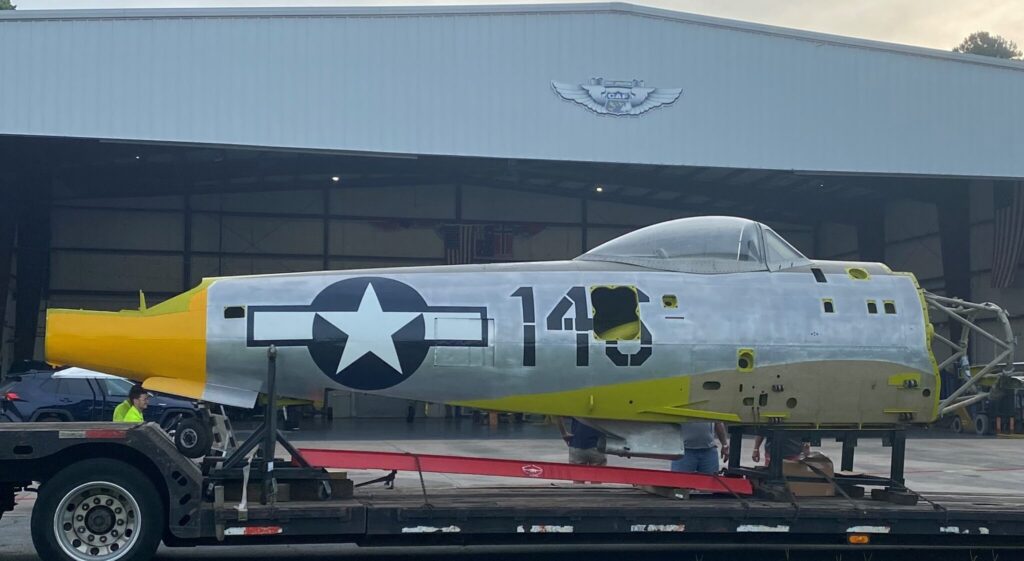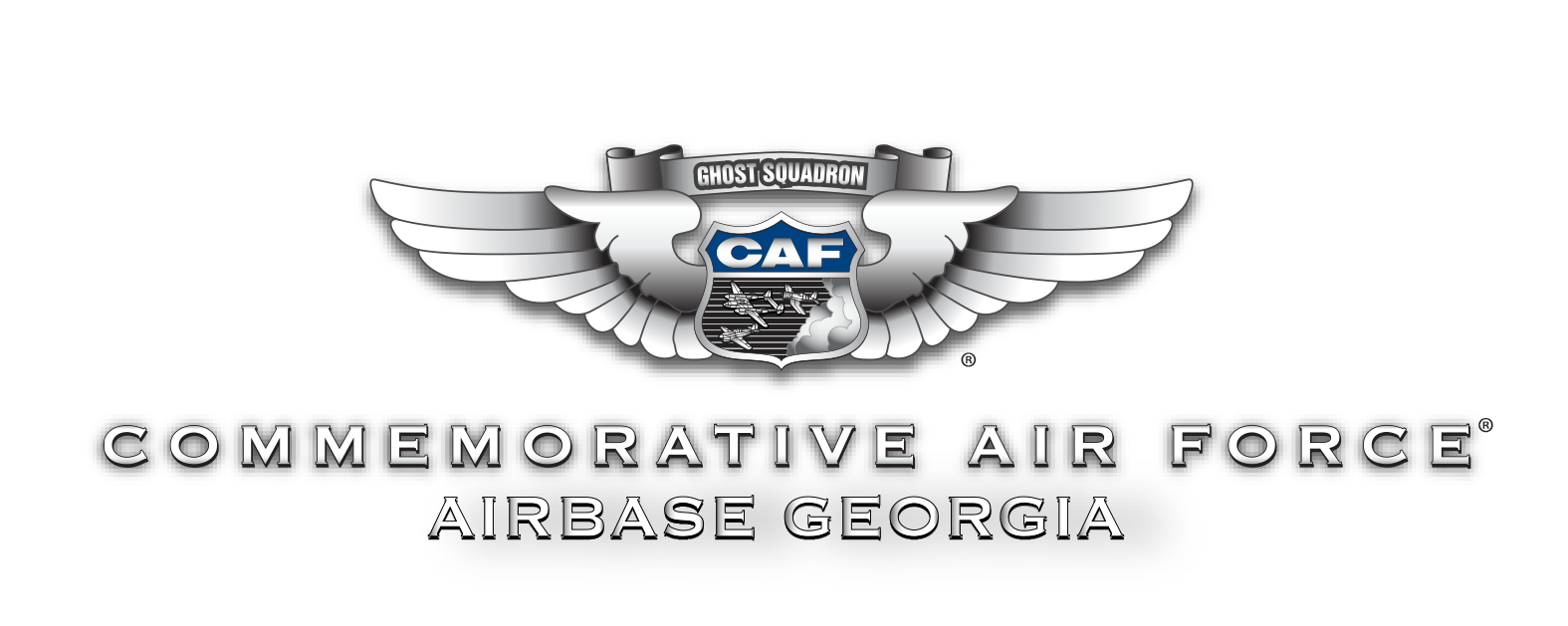
Affectionately nicknamed “Jug,” the P-47 was one of the most famous AAF fighter planes of World War II. Although originally conceived as a lightweight interceptor, the P-47 developed as a heavyweight fighter and made its first flight on May 6, 1941. The first production model was delivered to the AAF in March 1942, and in April 1943 the Thunderbolt flew its first combat mission — a sweep over Western Europe. Used as both a high-altitude escort fighter and a low-level fighter-bomber, the P-47 quickly gained a reputation for ruggedness. Its sturdy construction and air-cooled radial engine enabled the Thunderbolt to absorb severe battle damage and keep flying. During WWII, the P-47 served in almost every active war theater and in the forces of several Allied nations. By the end of WWII, more than 15,600 Thunderbolts had been built.
Production P-47B, C, early D and G series aircraft were built with metal-framed “greenhouse”-type cockpit canopies. Late D series (dash 25 and later) aircraft and all M and N series production aircraft were given clear “bubble” canopies, which gave the pilot improved rearward vision. (Source: National Museum of the United States Air Force)
Our P-47
While this particular Thunderbolt did not see combat while serving with the US military, it did have an interesting career south of the border in Central America. Our Republic F-47N Thunderbolt 44-89136, currently stored inside our hangar, was a legend in Guatemala and Nicaragua during its service there. The airplane went to the Nicaraguan Air Force (Fuerza Aérea de la Guardia Nacional) on June 24th, 1954, coming from the retiring Puerto Rico Air National Guard (PRANG) stock with two other examples. They joined three F-47Ns that had arrived in Nicaragua six days earlier. Nicaragua had already loaned two of these F-47s to the Liberation Army of Guatemala`s Air Force on June 18th, for its planned 10-day campaign against the leftist Guatemalan government. Both of the Liberation Army’s F-47s were soon out of operation due to hard landings to one aircraft on June 19th and the other on June 21st, which damaged their undercarriages. Spare parts were non-existent on site, so Nicaragua sent a third Thunderbolt to the Guatemalans on June 22nd. That airplane experienced engine failure soon after, so two of Nicaragua’s latest F-47 arrivals, including the 44-89136, immediately supplemented the depleted Guatemalan rebel forces. One of them suffered heavy anti-aircraft fire damage during a bombing mission on June 25th, knocking her out of action too, so Nicaragua sent their sixth and final F-47N to the cause. This smallest of air forces had just one operative airplane some days and none on others. At most, there were only ever two simultaneously operable F-47Ns to fly the planned, twice-daily missions. The airplanes flew without markings, in an overall coat of silver paint with a black, anti-glare panel in front of the cockpit.
Since the F-47Ns flew in pairs at most, and due to malfunctions, accidents, and battle damage, not to mention there only being three pilots, it was as if only two airplanes existed in the fleet. One Thunderbolt took a serious hit from the anti-aircraft fire on the last day of aerial operations. The pilot tried to land his stricken fighter on a dirt strip in liberated territory, but it was too short and the aircraft overran the runway and then proceeded to bounce down a ravine. The pilot was lucky enough to survive, but the Thunderbolt was a write-off. It was the only loss of the entire air campaign.
Of the six Thunderbolts to serve the Guatemalan rebels, only 44-89136 escaped unscathed from the 32 missions flown in support of the insurgent land operations that culminated in the collapse of Guatemala’s sitting government. As a result, it was the only example incorporated into the unified Guatemalan Air Force on July 3rd, 1954. The Thunderbolt was popularly known in Guatemala as The Sulfur, or “El Sulfato”, a nickname the Guatemalan people bestowed upon the aircraft, because of the effect their presence over Guatemala City had upon government officials at the time.
After the end of hostilities, an Agreement to unite the National Army with the Liberation Army into a new Guatemalan Army solved the final situation of “one country, two armies”. Our F-47N arrived solo at La Aurora air base in Guatemala City. Gerald Delarm Amador was at the controls. Two weeks later, she received Guatemalan Air Force colors and serial number 0658. She flew solely to train two Guatemalan pilots on the type, while the other pilots in training at the time learned to fly the new F-51D Mustangs that the Air Force began to receive in those same days.
Interestingly, even though major fighting was over, the conflict sparked up again briefly following the rebel victory. A small force, composed mainly of Military School cadets, fired upon a hospital under construction, which was temporarily housing a detachment of the rebel Liberation Army that had come to Guatemala City to join in a combined parade the day before. The cadets were demanding the dissolution of the Liberation Army, still a parallel force, and the immediate formation of a new National Army, in advance of the date previously agreed upon. Gerald Delarm Amador flew a sortie in his lone F-47 during this skirmish on August 2nd, but the Air Force grounded the fighter soon after, declaring itself unwilling to fire upon the cadets. On December 13th, 1954, Delarm Amador flew “The Sulfur” back to Managua, Nicaragua, to return her to the Nicaraguan Air Force, who kept it without markings. In exchange, the Guatemalan Air Force received an ex-Swedish Air Force F-51D Mustang. Amador continued to fly the 44-89136 for Nicaragua. On January 15th, 1955, during a border dispute with Costa Rica, Amador shot down an opposing F-51D Mustang with his Thunderbolt. And thus, 44-89136 was the last F-47N ever to have an aerial victory.
Sometime later, 44-89136 finally received her Nicaraguan colors, wearing the military serial number GN-71. She never fired her guns in anger again, serving Nicaragua peacefully until the end of her military service in 1963. One of the CAF’s founding members, Lloyd P. Nolen, bought the Thunderbolt on February 11th, 1963 and brought her back to the USA to become part of the nascent Confederate Air Force (now known as the Commemorative Air Force). And there her American history began again! We are currently in the process or restoring this aircraft to her former glory. If you would like to be a part of this effort, join Airbase Georgia and lend a hand!

